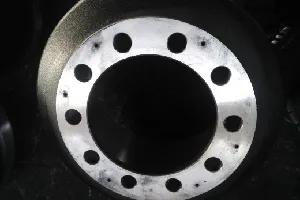Feb . 20, 2025 06:36
Back to list
function of brake drum
The brake drum is a critical component of a vehicle's braking system, performing a pivotal role in ensuring safety on the road. In an era where innovation drives automotive technology, it's essential to appreciate the intricate design, operational dynamics, and advances in the function of the brake drum, which underpins its effectiveness and reliability.
Furthermore, in commercial vehicles, brake drums are frequently paired with air brake systems due to their robustness and reliability. Air brakes provide consistent and powerful performance, crucial for the demanding requirements of heavy-duty vehicles. This synergy between brake drums and air systems underscores the authoritative preference in industries where safety and durability cannot be compromised. Expertise in evaluating and choosing brake drums involves assessing factors like size, heat tolerance, and compatibility with other braking components. For automotive enthusiasts and professionals, the ability to discern the right specifications ensures optimal performance tailored to specific vehicle needs. It's this expertise that guarantees the reliability and safety of a vehicle's braking system, adhering to industry standards and regulations. Additionally, maintaining the brake drum system is paramount for long-term trustworthiness. Regular inspection of the brake shoes, drum surface, and hydraulic components can preempt failures and ensure consistent braking performance. Recognizing signs of wear, such as scoring or a glazed appearance on the drum surface, can inform timely interventions, safeguarding vehicle operators and passengers alike. In today's automotive world, the function of the brake drum continues to be relevant, particularly in applications where reliability and durability are prioritized over the lightweight and performance-oriented characteristics of disc brakes. This traditional yet robust component exemplifies the balance between engineering simplicity and mechanical efficiency, maintaining its authority in various vehicular applications. For consumers and manufacturers alike, knowledge of brake drum functionality extends beyond mere component recognition; it embodies a commitment to safety, efficiency, and mechanical integrity. As the automotive landscape evolves, the timeless design of brake drums will undoubtedly adapt, embracing new materials and technologies to meet emerging vehicular challenges, ensuring they remain an integral part of automotive braking solutions.


Furthermore, in commercial vehicles, brake drums are frequently paired with air brake systems due to their robustness and reliability. Air brakes provide consistent and powerful performance, crucial for the demanding requirements of heavy-duty vehicles. This synergy between brake drums and air systems underscores the authoritative preference in industries where safety and durability cannot be compromised. Expertise in evaluating and choosing brake drums involves assessing factors like size, heat tolerance, and compatibility with other braking components. For automotive enthusiasts and professionals, the ability to discern the right specifications ensures optimal performance tailored to specific vehicle needs. It's this expertise that guarantees the reliability and safety of a vehicle's braking system, adhering to industry standards and regulations. Additionally, maintaining the brake drum system is paramount for long-term trustworthiness. Regular inspection of the brake shoes, drum surface, and hydraulic components can preempt failures and ensure consistent braking performance. Recognizing signs of wear, such as scoring or a glazed appearance on the drum surface, can inform timely interventions, safeguarding vehicle operators and passengers alike. In today's automotive world, the function of the brake drum continues to be relevant, particularly in applications where reliability and durability are prioritized over the lightweight and performance-oriented characteristics of disc brakes. This traditional yet robust component exemplifies the balance between engineering simplicity and mechanical efficiency, maintaining its authority in various vehicular applications. For consumers and manufacturers alike, knowledge of brake drum functionality extends beyond mere component recognition; it embodies a commitment to safety, efficiency, and mechanical integrity. As the automotive landscape evolves, the timeless design of brake drums will undoubtedly adapt, embracing new materials and technologies to meet emerging vehicular challenges, ensuring they remain an integral part of automotive braking solutions.
Prev:
Next:
Latest news
-
Brake Drums for Trucks | OEM-Grade, Factory DirectNewsNov.10,2025
-
High-Performance Brake Drums for Trucks | OEM & ISONewsNov.10,2025
-
Brake Drums Built to Last — OEM-Grade, Balanced for TrucksNewsNov.10,2025
-
Brake Drums for Trucks – OEM-Grade, Durable, Low NoiseNewsNov.10,2025
-
Brake Drums for Trucks | OEM, ISO-Certified, Fast DeliveryNewsNov.10,2025
-
Brake Drums: OEM-Grade, Precision Balanced, Factory DirectNewsNov.03,2025
-
Brake Drums: Heavy-Duty, OEM-Grade, Precision-BalancedNewsNov.03,2025


